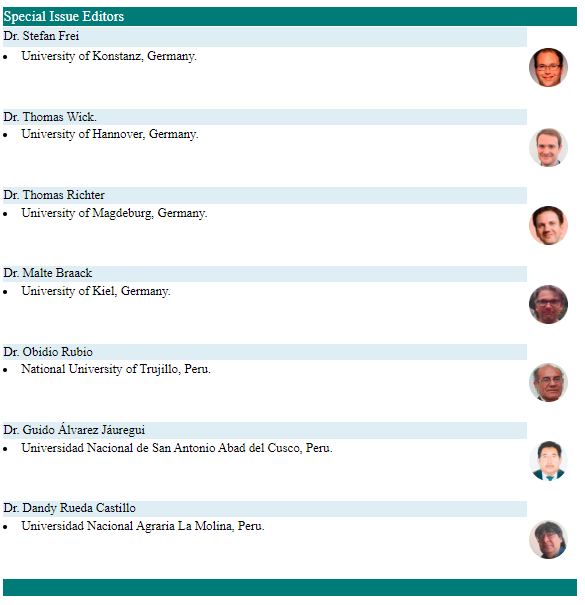The SIRD epidemiological model using Caputo fractional derivatives applied to study the spread of the COVID-19 in the Peruvian region of Tacna
DOI:
https://doi.org/10.17268/sel.mat.2024.02.03Palavras-chave:
Fractional ordinary differential equations, Fractional derivatives and integrals, Caputo fractional derivative, SIRD model for infectious diseasesResumo
Mathematical models are widely used to study the spreading dynamics of infectious diseases. In particular, the “Susceptibles-Infecteds-Recovereds-Deceases”(SIRD) model provides a framework that can be adapted to describe the core spreading dynamics of several human and wildlife infectious diseases. The present work uses a SIRD model using Caputo fractional derivative. In this investigation, the existence and uniqueness of solutions for the model were established. Numerical solutions were obtained using the Adams-Bashforth method. To illustrate the model’s utility, we made forecasts for the spread of the virus SARS-Cov-2 in the region of Tacna in Perú.
It is well known that these models can help to forecast the number of infected people, understand the disease dynamics and evaluate potential control strategies.
Referências
Benedictow OJ. The complete history of the Black Death. Woodbridge: Boydell & Brewer; 2021.
Kermack WO, McKendrick AG. A contribution to the mathematical theory of epidemics. Proceedings of the Royal Society of London Series A, Containing papers of a mathematical and physical character. 1927;115(772):700 -721.
Coayla-Teran EA. A COVID-19 time-dependent SIRD model using functional differential equations. International Journal of Ecology and Development. 2021;36(3):1-11.
Nisar KS, Ahmad S, Ullah A, Shah K, Alrabaiah H, Arfan M. Mathematical analysis of SIRD
model of COVID-19 with Caputo fractional derivative based on real data. Results in Physics.
;21:103772. Available from: https://www.sciencedirect.com/science/article/
pii/S2211379720321823.
Rezapour S, Mohammadi H, Samei ME. SEIR epidemic model for COVID-19 transmission by Caputo derivative of fractional order. Advances in difference equations. 2020;2020:1-19.
Alshomrani AS, Ullah MZ, Baleanu D. Caputo SIR model for COVID-19 under optimized fractional order. Advances in Difference Equations. 2021;2021(1):185.
Kilbas AA, Srivastava HM, Trujillo JJ. Theory and applications of fractional differential equations. vol. 204. Amsterdam: Elsevier; 2006.
Vargas-Pichón HB, Coayla-Teran EA, Tejada-Vásquez E. The SIRD epidemiological model applied to spread of the COVID-19 in the Peruvian region of Tacna. Selecciones Matemáticas. 2022;9(01):137 -144.
Vergara-Moreno E, et al. Modelo básico epidemiológico SIR para el COVID-19: caso las Regiones del Perú. Selecciones Matemáticas. 2020;7(01):151 -161.
DIRESA. Health directory of Tacna region in Peru;. May 2023. Available from: https://www.facebook.com/drstacna.
INEI. National Institute of Statistics and Computing of Peru;. June 2020. Available from:
https://www.inei.gob.pe/media/MenuRecursivo/publicacionesdigitales/Est/Lib1715/libro.pdf.
Brauer F, Castillo-Chavez C. Mathematical models in population biology and epidemiology. vol. 2. New York: Springer; 2012.
Downloads
Publicado
Como Citar
Edição
Seção
Licença

Este trabalho está licenciado sob uma licença Creative Commons Attribution 4.0 International License.
Os autores que publicam nesta revista aceitam as seguintes condições:
Os autores mantêm os direitos autorais e atribuem à revista o direito da primeira publicação, com o trabalho registrado com a licença de atribuição Creative Commons Atribución 4.0 Internacional (CC BY 4.0), que permite que terceiros usem o material publicado sempre que mencionarem a autoria do trabalho e os direitos autorais. Primeira publicação nesta revista.
Os autores podem fazer outros acordos contratuais independentes e adicionais para a distribuição não exclusiva da versão do artigo publicada nesta revista (por exemplo, incluí-la em um repositório institucional ou publicá-la em um livro), desde que afirme claramente que o trabalho Foi publicado nesta revista.
É permitido e recomendado aos autores que publiquem seus trabalhos na Internet (por exemplo, em páginas institucionais ou pessoais) antes e durante o processo de revisão e publicação, pois isso pode levar a trocas produtivas e a uma disseminação maior e mais rápida do trabalho. publicado (Consultar: efeito do acesso aberto).












